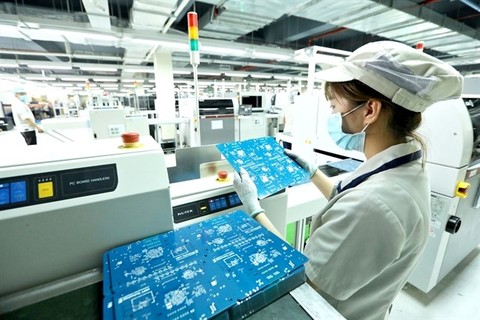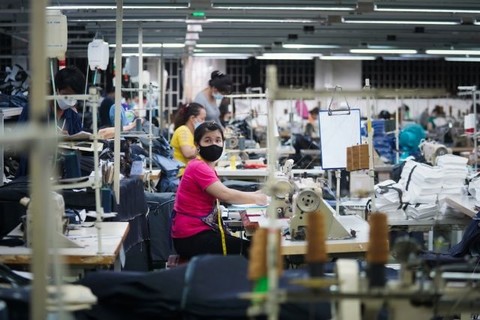
Prime Minister Phạm Minh Chính visited the Việt Nam International Innovation Expo 2023 (VIIE 2023) in Hà Nội last October. The event has played a crucial role in raising awareness about the importance of innovation and its potential to drive economic and social progress. — VNA/VNS Photo
Việt Nam must continue to innovate its growth model by focusing on high technology, supporting innovative startups, and transitioning to a green economy, according to experts.
Last week, Politburo member and Prime Minister Phạm Minh Chính, head of the sub-committee for socio-economic affairs of the 14th National Party Congress [slated for early 2026], chaired the third meeting of this sub-committee.
The event reviewed the sub-committee’s work since its last meeting and discussed a draft report on the first five years of implementing the 2021-2030 socioeconomic development strategy. The meeting also considered draft orientations and tasks for socioeconomic development during 2026-2030, ahead of their submission to the Politburo and the 10th session of the current 13th Party Central Committee.
In his address, the PM emphasised that economic development remained the central priority. He called for revitalising traditional growth drivers while vigorously advancing new sources of growth.
At the annual World Economic Forum (WEF) in Dalian, China, in June, PM Chính highlighted Việt Nam’s journey of innovation, integration, and development. He said that Việt Nam would continue prioritising growth through flexible policies suited to the country’s conditions, circumstances, and global trends.
Việt Nam’s strategy involves renewing traditional growth drivers like investment, exports, and consumption while aggressively promoting new ones. Priority sectors include the digital economy, green economy, circular economy, sharing economy, and knowledge economy. The government is focusing on mobilising resources through enhanced public-private partnerships, prioritising public investment to lead private investment, and activating all social resources for growth and development.

A terminal equipment production line of VNPT Technology, a pioneering division within the Việt Nam Posts and Telecommunications Group, spearheading innovations in telecommunications, information technology, and digital content. — VNA/VNS Photo
Assoc. Prof. Bùi Quang Tuấn, former director of the Việt Nam Economic Institute, noted that Việt Nam was widely recognised for its robust economic growth. In the first half of 2024, the economy posted a significant GDP growth rate of 6.42 per cent compared to the same period in 2023, with forecasts suggesting nearly 7 per cent growth by year-end. This marks the fourth consecutive quarter of surpassing expectations.
"Việt Nam's economic expansion is driven by various sectors, including agriculture, forestry, fisheries, services, industry, and construction. Emerging contributors like the digital economy, total factor productivity (TFP), labour productivity, and green economy are also playing key roles in boosting GDP growth," Tuấn said.
However, he warned that Việt Nam’s economic growth still relied on an outdated model, with a growing dependence on capital and human resources while the contribution of TFP and labour productivity was gradually diminishing. Investments remained the primary driver of growth, with human capital playing a more crucial role than mere labour input.
Tuấn said that while Việt Nam’s economic structure was gradually transitioning towards modernisation, the pace had been slow over the past five years. The shift to a more service-oriented economy had been challenging, as agriculture, forestry, and fisheries still held significant shares. Weak TFP growth further complicated the situation, exacerbating regional disparities.
Tuấn noted the limited progress in growth driven by innovation, technology, skills, and integration into global value chains.
According to Tuấn, the current growth model heavily relies on inexpensive labour, resulting in a dual economy with limited spillover effects from the foreign-invested sector, particularly in technological capabilities. Notably, the foreign direct investment (FDI) sector’s exports account for 71 per cent of the total.
Việt Nam's investment in science, technology, and innovation is only a quarter of the global average, at about 0.56 per cent of GDP compared to the global average of 2.2 per cent. The country’s institutions for science, technology, and innovation remain underdeveloped, with limited breakthroughs. Private sector investment in research and development (R&D) is also low, at just 0.44 per cent, whereas in South Korea, it exceeds 80 per cent.
Despite some progress, Việt Nam’s labour productivity growth remains modest. From 2016 to 2020, labour productivity grew at an average annual rate of 5.8 per cent, up from 4.3 per cent during 2011-2015. However, this growth lags China’s 7 per cent and India’s 6 per cent.
Việt Nam’s labour productivity is now among the lowest in the region, just above Laos. The private sector, contributing 44 per cent to GDP, has not yet reached its potential, with most Vietnamese enterprises being small and few large corporations existing.

The digital economy, total factor productivity (TFP), labour productivity, and green economy are playing key roles in boosting GDP growth. — VNA/VNS Photo
The transition to a green growth model has also had limited impact on sustainable development. The circular economy is still in its early stages, and the blue economy remains largely untapped. Although institutional improvements have been made, significant bottlenecks persist, particularly in science, technology, innovation, and emerging economic sectors like the sharing economy, fintech, and data analytics.
However, Tuấn sees significant opportunities for Việt Nam to transform its growth model through innovations in key areas such as the Fourth Industrial Revolution, emerging technology trends, green and digital advancements, continued integration, and the rise of innovation and startup movements. The country’s young population, combined with improved access to cutting-edge technology, positions Việt Nam well to enhance production, distribution, and consumption processes.
"To effectively innovate our growth model, we need to focus on new growth drivers such as science, technology, innovation, digital transformation, and green transformation. Previously, these were just concepts; now we need to implement them to achieve quality growth," Tuấn said.
He also stressed the importance of attracting high-quality talent both domestically and internationally. Achieving the vision of becoming a green powerhouse and digitalising the economy would require developing supportive institutions and policies. It was essential to foster green and digital ecosystems, encourage innovation, and create linkages within these ecosystems.
Prof. Hoàng Văn Cường, a member of the National Assembly's Finance and Budget Committee, echoed these sentiments, saying that transforming the growth model would require a fundamental shift from relying on resources and cheap labour to embracing science, technology, and green practices.
“Việt Nam must overhaul its traditional approaches and fully embrace new trends like digital and green transformations to drive growth,” he said.
Economist Võ Trí Thành said that while discussions about Việt Nam's economic growth model had been ongoing for over a decade, turning the aspiration for innovation into reality was challenging. He emphasised that Việt Nam must be proactive and simultaneous in its efforts to avoid missing opportunities.
“Green and creative transformations present golden opportunities for Việt Nam,” Thành said.
“These opportunities are particularly significant as the global market is just beginning to explore them. The ongoing industrial revolution, marked by rapid changes, will offer various choices and require adaptive policy shifts.”
Phạm Anh Cường, CEO of BestB Start-up Ecosystem, noted that while the rate of new businesses entering the market in Việt Nam was higher than in most Organisation for Economic Co-operation and Development countries, sustainable growth required strong support and connections among incubators, business promotion organisations, and creative startup investment funds. Such support was crucial for helping innovative startups refine their ideas, services, and business models while linking them with investors.
In addition to focusing on technological innovation and startups, there is also a strong emphasis on transitioning to a green economy and adopting circular economic development.
These models promote sustainable development by reducing environmental pollution and using resources more efficiently. The integration of new technologies, such as AI, blockchain, and the Internet of Things, not only optimises production processes but also helps mitigate negative environmental impacts. — VNS